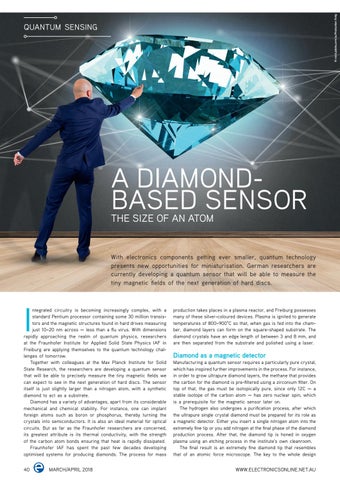© stock.adobe.com/au/Production Perig
QUANTUM SENSING
A DIAMONDBASED SENSOR THE SIZE OF AN ATOM
With electronics components getting ever smaller, quantum technology presents new opportunities for miniaturisation. German researchers are currently developing a quantum sensor that will be able to measure the tiny magnetic fields of the next generation of hard discs.
I
ntegrated circuitry is becoming increasingly complex, with a standard Pentium processor containing some 30 million transistors and the magnetic structures found in hard drives measuring just 10–20 nm across — less than a flu virus. With dimensions rapidly approaching the realm of quantum physics, researchers at the Fraunhofer Institute for Applied Solid State Physics IAF in Freiburg are applying themselves to the quantum technology challenges of tomorrow. Together with colleagues at the Max Planck Institute for Solid State Research, the researchers are developing a quantum sensor that will be able to precisely measure the tiny magnetic fields we can expect to see in the next generation of hard discs. The sensor itself is just slightly larger than a nitrogen atom, with a synthetic diamond to act as a substrate. Diamond has a variety of advantages, apart from its considerable mechanical and chemical stability. For instance, one can implant foreign atoms such as boron or phosphorus, thereby turning the crystals into semiconductors. It is also an ideal material for optical circuits. But as far as the Fraunhofer researchers are concerned, its greatest attribute is its thermal conductivity, with the strength of the carbon atom bonds ensuring that heat is rapidly dissipated. Fraunhofer IAF has spent the past few decades developing optimised systems for producing diamonds. The process for mass
40 MARCH/APRIL 2018
production takes places in a plasma reactor, and Freiburg possesses many of these silver-coloured devices. Plasma is ignited to generate temperatures of 800–900°C so that, when gas is fed into the chamber, diamond layers can form on the square-shaped substrate. The diamond crystals have an edge length of between 3 and 8 mm, and are then separated from the substrate and polished using a laser.
Diamond as a magnetic detector Manufacturing a quantum sensor requires a particularly pure crystal, which has inspired further improvements in the process. For instance, in order to grow ultrapure diamond layers, the methane that provides the carbon for the diamond is pre-filtered using a zirconium filter. On top of that, the gas must be isotopically pure, since only 12C — a stable isotope of the carbon atom — has zero nuclear spin, which is a prerequisite for the magnetic sensor later on. The hydrogen also undergoes a purification process, after which the ultrapure single crystal diamond must be prepared for its role as a magnetic detector. Either you insert a single nitrogen atom into the extremely fine tip or you add nitrogen at the final phase of the diamond production process. After that, the diamond tip is honed in oxygen plasma using an etching process in the institute’s own cleanroom. The final result is an extremely fine diamond tip that resembles that of an atomic force microscope. The key to the whole design
WWW.ELECTRONICSONLINE.NET.AU
